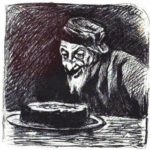Food and the Jews of Alsace-Loraine
by David P. Rosenberg, M.P.A., Reference Services Research Coordinator, Center for Jewish History
“Circles of Justice: Law, Culture and the Jews of Metz in 18th Century France” is now on view in The David Berg Rare Book Room here at the Center. Related programming includes “Sex, Yiddish and the Law: Jewish Life in Metz in the 18th Century” this Monday, October 21 at 6:30pm.
In exploring the history of the Jews of Alsace-Lorraine, I discovered sources that revealed the importance of food-culture in this region.
The 1886 Leon Cahun work La Vie Juive has “ein Alcase” neatly penciled on the title page. This work has not only descriptions of the Sabbath meal, but also a surprising number of illustrations devoted to the subject and other holiday meals. The number of illustrations was particularly striking considering its 19th-century imprint.
My favorites include a cheerful older woman with covered hair making matzah balls, an older man infatuated with a cake (see above), the spectacle of a matza bakery at its busiest time along and holiday scenes at the table. You can see all the illustrations by d’Alphonse Levy online. The physical book is available in the Lillian Goldman Reading Room here at the Center, and you can view its digitized version on archive.org.
I also looked at Juifs en Alsace; culture, societe, histoire. The Leo Baeck Institute at the Center holds book number 746 of 2600. This French work published in 1977 has a sizable section devoted to “Cuisine Judeo-alsacienne.” It starts with a discussion of the importance of dietary laws and includes terms like “Cachere,” “Treife,” “Milchig” and “Fleichig.”
I had someone with more intimate knowledge of French help me understand some of the other terms. I thought it was interesting that for Yom Kippur, “Kalbsvoresse, ragout de veau,” (veal stew) and Apfelkrapfel, Pommes decoupees” (sliced apples with raisins, almonds and cinnamon) were the standard fare. For Hanukkah, “Matseknepfle” (matzah balls), “Grive” (thrush), “Gfeltes Gänsehälsel” (stuffed neck of thrush) and “Gänse Voresse” (oven roasted thrush) were mentioned. Thrush is a game bird. I learned that these recipes may actually be referring to goose, which was an important part of the culture and economy of the people of Alsace-Lorraine.
In my next post, I will look at recipes for goose and other Alsatian specialties. In future entries, I’ll examine the economic lives of the Jews of the region. Emancipation drastically affected Jews economically, which is a topic that will be addressed in a roundtable discussion on Monday, December 9, at 6:30pm, “French and Jewish: Defining a Modern Jewish Identity in the 19th Century.”
The changes that came with emancipation affected everyone, musicians among them. A concert and lecture on Monday, November 18, at 8:00pm will celebrate Charles-Valentin Alkan and his Music, who had roots in Metz.
To learn more about our current exhibition and related programming, click here.
–
This fall, the YIVO Institute and the Center for Jewish History present an exhibition, a symposium and four public programs that explore the Jewish community in Metz, France in the 18th and 19th centuries. These programs were inspired by the Pinkas (Register) of the Metz Rabbinic Court, a rare and little-known document from the collections of the YIVO Institute Archives.
The exhibition and program series is made possible by the generous support of The David Berg Foundation and Selz Foundation. Additional support has been provided by Emil Kleinhaus.

